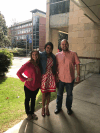Narratives of Undergraduate Research, Mentorship, and Teaching at UCLA
- PMID: 33935303
- PMCID: PMC8081390
- DOI: 10.1515/pac-2020-1007
Narratives of Undergraduate Research, Mentorship, and Teaching at UCLA
Abstract
This work describes select narratives pertaining to undergraduate teaching and mentorship at UCLA Chemistry and Biochemistry by Alex Spokoyny and his junior colleagues. Specifically, we discuss how individual undergraduate researchers contributed and jump-started multiple research themes since the conception of our research laboratory. This work also describes several recent innovations in the inorganic and general chemistry courses taught by Spokoyny at UCLA with a focus of nurturing appreciation for research and creative process in sciences including the use of social media platforms.
Keywords: boron clusters; chemistry Twitter; chemistry appreciation; inorganic chemistry; mentorship; science communication; science literacy; undergraduate research.
Figures










Similar articles
-
The 2009 Lindau Nobel Laureate meeting: Martin Chalfie, Chemistry 2008.J Vis Exp. 2010 Feb 10;(36):1570. doi: 10.3791/1570. J Vis Exp. 2010. PMID: 20147885 Free PMC article.
-
Teaching microbiology to undergraduate students in the humanities and the social sciences.FEMS Microbiol Lett. 2015 Oct;362(19):fnv162. doi: 10.1093/femsle/fnv162. Epub 2015 Sep 10. FEMS Microbiol Lett. 2015. PMID: 26363013
-
Innovations in student-centered interdisciplinary teaching for general education in aging.Gerontol Geriatr Educ. 2008;29(3):270-89. doi: 10.1080/02701960802359516. Gerontol Geriatr Educ. 2008. PMID: 19042506
-
Building a laboratory at a Primarily Undergraduate Institution (PUI).BMC Proc. 2021 Jun 22;15(Suppl 2):2. doi: 10.1186/s12919-021-00208-5. BMC Proc. 2021. PMID: 34158023 Free PMC article. Review.
-
Animal sciences undergraduate education since the ASAS centennial: a national survey and scoping review.Transl Anim Sci. 2020 Nov 7;4(4):txaa202. doi: 10.1093/tas/txaa202. eCollection 2020 Oct. Transl Anim Sci. 2020. PMID: 33336155 Free PMC article.
References
-
- Dziedzic R. M., Saleh L. M. A., Stevens S. L., Martin J. L., Royappa A. T., Rheingold A. L., Spokoyny A. M. J. Am. Chem. Soc. . 2016;138:9081. - PubMed
-
- Queen J. D., Phung A. C., Caputo C. A., Fettinger J. C., Power P. P. J. Am. Chem. Soc. . 2020;142:2233. - PubMed
-
- Gonzalez A., Kengmana E. S., Fonseca M. V., Han G. G. D. Mater. Today Adv. . 2020;6:100058.
Grants and funding
LinkOut - more resources
Full Text Sources
Other Literature Sources
